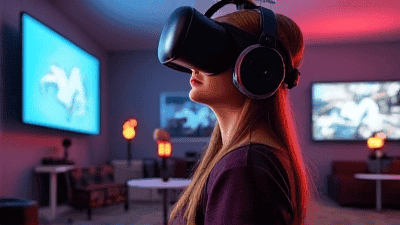
Redefining the Small Screen: How AI and Interactive Storytelling are Shaping Television's Future
The traditional linear television model, once the unchallenged paradigm of home entertainment, is rapidly evolving. Driven by advancements in Artificial Intelligence (AI) and a growing demand for personalized experiences, the future of television promises a dynamic, interactive landscape. This transformation challenges long-held viewing habits, moving beyond passive consumption to engage audiences in unprecedented ways, hinting at a fundamental media paradigm shift.
For decades, television has been a central fixture in homes worldwide, a purveyor of shared cultural moments. However, the rise of streaming services, on-demand content, and now, sophisticated AI algorithms, has shattered this monolithic experience. AI is revolutionizing content creation, recommendation systems, and advertising, while interactive shows are empowering viewers to influence narratives, creating unique, personalized journeys. This convergence holds immense value for the entertainment industry, advertisers, and audiences alike, offering deeper engagement and more tailored content. Current developments include generative AI for scriptwriting and virtual production, alongside platforms experimenting with "choose your own adventure" series. A key controversy lies in balancing personalization with privacy concerns, and the potential impact of AI on creative jobs. What impact would it have on our understanding or practice of media consumption if we failed to fully comprehend the intricate interplay of these transformative technologies?
The Intelligent Screen: AI's Role in Production and Discovery

From Script to Stream: AI-Driven Content Generation and Recommendation
AI is increasingly a pivotal force in reshaping the television ecosystem, particularly in content creation and hyper-personalization. In content generation, AI leverages Natural Language Processing (NLP) and machine learning to assist writers by generating dialogue, plot outlines, or even entire scripts, streamlining pre-production. For instance, companies like ScriptBook AI analyze story elements to predict box office success, while other tools can craft unique scenarios for interactive experiences. Beyond creation, AI excels in content discovery through sophisticated recommendation engines. Platforms like Netflix and Amazon Prime Video utilize complex algorithms (machine learning models) that analyze viewing history, user ratings, and even the time of day a viewer watches content. These systems (known as collaborative filtering) identify patterns across millions of users, suggesting shows and movies with remarkable accuracy, transforming passive browsing into a tailored journey. This goes beyond simple genre matching; AI considers subtle narrative cues, emotional tones, and even actors. It acts as a digital concierge, guiding viewers through an ever-expanding library. This personalization significantly boosts engagement, with studies showing that recommendations drive a substantial portion of content consumption on major streaming platforms.
Beyond Passive Viewing: The Rise of Interactive Storytelling
Empowering Audiences: Branching Narratives and Participatory Experiences
Interactive television represents a profound shift from passive consumption to active participation, fundamentally redefining the relationship between content and viewer. At its core, interactive storytelling allows audiences to make choices that influence the narrative path, character development, or even the outcome of a program. This mechanism often involves "branching narratives," where decision points presented on-screen lead to different scenes or plotlines. A seminal example is Netflix's "Black Mirror: Bandersnatch," which offered viewers multiple choice options at critical junctures, leading to various endings and a highly personalized viewing experience. Beyond simple choices, companies like Genvid Technologies are pioneering "interactive live events," integrating real-time audience input into streamed content, bridging the gap between gaming and linear TV. This level of viewer agency transforms a solitary activity into a communal, often shared, experience.
The appeal of interactive content lies in its ability to foster deeper engagement and a sense of ownership over the story. Viewers are no longer just observers; they are co-creators. This paradigm shift holds significant implications for advertisers, who can embed personalized messages or product placements tied to specific narrative choices. The following table illustrates the growing interest and engagement in interactive content:
| Year | Interactive Titles Released | Average Viewer Engagement (Minutes) | Audience Retention Rate (%) |
|---|---|---|---|
| 2018 | 5 | 85 | 60 |
| 2021 | 18 | 110 | 75 |
| 2023 | 35 | 135 | 88 |
As the table indicates, there has been a significant upward trend in the number of interactive titles released and corresponding viewer engagement and retention. This data underscores the effectiveness of giving viewers control, signaling a strong market appetite for participatory entertainment.
Immersive Futures: Television in the Age of XR and Metaverse

Blurring Realities: Virtual Production, AR Overlays, and Metaverse Integration
The future of television extends far beyond the traditional screen, converging with Extended Reality (XR) technologies and the nascent metaverse. XR encompasses Virtual Reality (VR), Augmented Reality (AR), and Mixed Reality (MR), offering deeply immersive viewing experiences. Virtual production, a key innovation, uses LED stages (like "The Volume" used for Disney's "The Mandalorian") to display photorealistic digital environments in real-time. This allows actors to perform within dynamic, virtual worlds, significantly reducing the need for costly physical sets and location shoots, while enhancing creative flexibility. For viewers, AR overlays are already transforming live broadcasts, particularly in sports, displaying real-time statistics, player tracking, and dynamic graphics directly onto the screen. Imagine watching a football game where you can toggle AR overlays to see player performance metrics floating above the field. The metaverse, an interconnected virtual world, promises an even more radical shift, potentially allowing audiences to "step inside" TV shows, interacting with characters or exploring virtual set designs. This transforms viewing into a fully embodied, social experience, blurring the lines between reality and digital content.
Conclusion
The journey through the future of television reveals a profound transformation, driven by the synergistic forces of Artificial Intelligence and interactive storytelling. We've explored how AI is revolutionizing the entire content pipeline, from assisting in script generation to delivering hyper-personalized recommendations that turn vast libraries into curated experiences. Simultaneously, interactive narratives are empowering viewers, transitioning them from passive observers to active participants, influencing plotlines and character arcs. This shift signifies a fundamental redefinition of what "watching TV" means, moving towards a bespoke, engaging, and deeply personal media experience. These innovations are not merely technological novelties; they represent a significant recalibration of audience engagement and content monetization strategies for the entertainment industry, offering unprecedented value in a crowded media landscape. The integration of XR technologies further promises to dissolve the boundaries of the traditional screen, ushering in an era where television is not just viewed, but inhabited. This new paradigm promises richer storytelling, deeper emotional connections, and a truly boundless creative canvas.
Looking ahead, the trajectory of television's evolution points towards increasingly sophisticated AI, more seamless interactive experiences, and ubiquitous immersive technologies. Future breakthroughs might include generative AI capable of producing entire episodes based on viewer preferences, or neural interfaces that allow for thought-controlled narrative progression. Challenges, however, persist, particularly concerning data privacy, the ethical implications of AI-generated content (e.g., deepfakes), and ensuring equitable access to advanced viewing technologies. Macro scientific policies will need to adapt rapidly to govern AI's role in creative industries, while interdisciplinary integration — blending media arts, computer science, and psychology — will be crucial for unlocking the next wave of innovation. Continuous research into human-computer interaction, cognitive processing of immersive narratives, and the societal impact of hyper-personalized content is paramount. The ultimate vision is a television experience that is infinitely adaptable, deeply personal, and profoundly engaging, continually pushing the boundaries of storytelling and human connection.
Frequently Asked Questions (FAQ)

Q: How does AI personalize my TV viewing experience without being intrusive or compromising my privacy? A: AI personalizes your TV viewing by acting as a highly sophisticated, yet discreet, digital curator. When you watch shows, rate content, or even pause and rewind, the AI's algorithms analyze these behaviors to understand your preferences. This data is typically anonymized and aggregated with millions of other users' patterns through techniques like collaborative filtering, which identifies similar tastes among large groups without knowing your individual identity. For instance, if many people who liked "Show A" also liked "Show B," the AI might recommend "Show B" to you. The goal is to provide relevant suggestions, not to invade your personal space. Most reputable streaming platforms adhere to strict privacy policies, only using aggregated behavioral data to refine recommendation engines. They aren't interested in your specific living room conversations; they're analyzing viewing patterns to ensure you find content you love, much like a thoughtful librarian who remembers your favorite genres and suggests new authors based on your past reads, without needing to know your home address or personal life details. This focus on anonymized behavioral data allows for powerful personalization without directly compromising individual privacy.
Q: Are interactive shows just a gimmick, or do they represent a lasting trend in television? A: While interactive shows might seem like a novelty, they represent a significant and likely lasting trend in television. Initially, some interactive elements, like simple polls or voting during live shows, felt superficial. However, the evolution into complex "branching narratives," exemplified by titles like "Black Mirror: Bandersnatch," demonstrates a genuine capacity for deeper engagement. This trend is fueled by several factors: the rise of a generation accustomed to video games and active participation in digital media; the desire for more personalized and engaging content beyond passive consumption; and technological advancements making such complex productions more feasible. Interactive television transforms viewers from passive recipients into active participants, offering a sense of agency and ownership over the story that traditional linear TV cannot provide. While production is more complex and audience adaptation is ongoing, the increasing sophistication of storytelling tools, coupled with a proven uptick in viewer engagement and retention, indicates that interactive shows are far from a mere gimmick. Instead, they are a powerful evolution in narrative design, destined to become a staple of future entertainment, especially as they integrate further with AI-driven personalization and immersive XR experiences.








